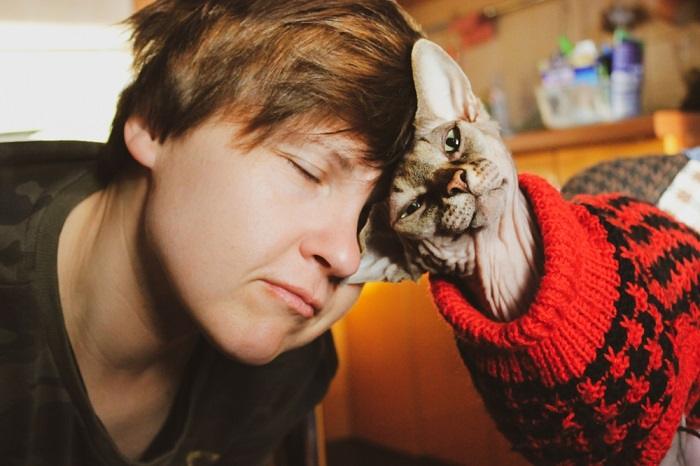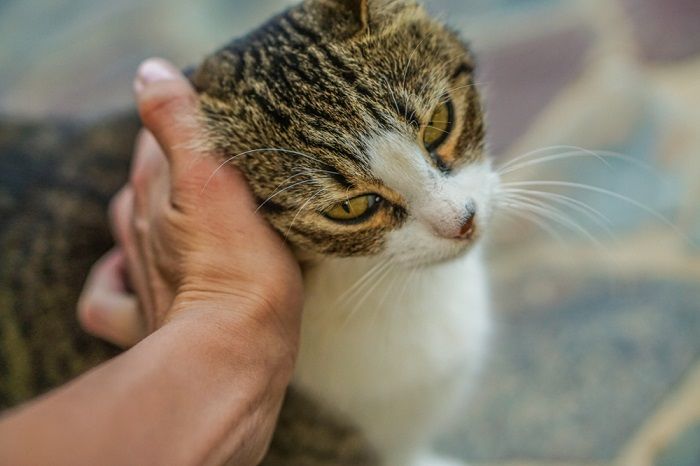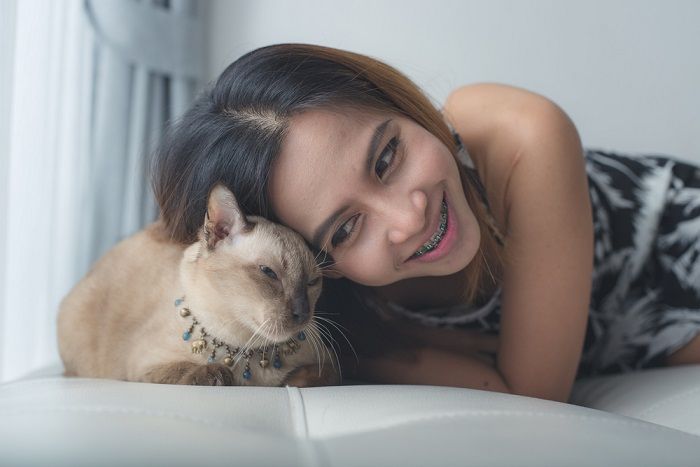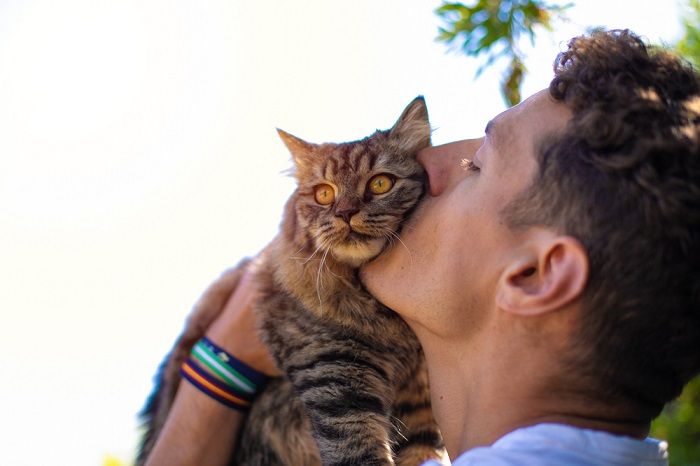
If you are a cat parent you will be familiar with the headbutt, and we’ve long been fascinated by what this body language means. Cats enjoy physical contact as a form of communication and affection. Most of us consider head bumping a display of affection or demand for attention, but what does it really mean?
When cats head bump they leave behind pheromones that are involved in scent marking.
A head bump is a sign of affection from your cat.
Not all cats head bump, but they will have other ways and body language to show affection or ask for attention.Key Takeaways
What Is a Head Bump?
Scent marking is an important form of communication for cats, not just to communicate with one another but with us, too. Cats have scent glands on their heads in the cheeks, chin, and forehead that produce pheromones—scents that humans cannot detect but other cats can. A head bump, or “head bunting,” is a way for cats to leave their scent on you or each other, to let other cats know that they’ve been there.
Every cat head bumps a bit differently. Sometimes it’s just a light bump, but sometimes it can be a bit more forceful! You should be flattered if your cat’s head bumps you—it’s a sign of affection and your cat will appreciate it if you bump them back or give them some love and affection. It can also be your cat’s way of letting you know they are hungry, or they want more attention.
Head Bumping or Head Pressing?
It’s very important to recognize the difference between head bumping and head pressing. A head bump is a short bump, often a one off but it can be followed by additional head bumps. Cats are usually relaxed when they head bump people or objects.
Head pressing is when a cat presses their head into a wall, corner, or other solid surfaces compulsively or for prolonged periods. Cats might seem unhappy or distressed when they do this.
Head pressing is a concerning behavior and a sign that you should take your cat to see a veterinarian as soon as possible. It is usually a sign of a neurological condition but can also be associated with liver failure. It’s often seen alongside other symptoms such as:
- Pacing
- Ataxia (walking like they are drunk)
- Disorientation
- Vision disturbances
Why Do Cats Head Bump?

Cats enjoy head bumping, which seems to make them feel happy and content.
We know that cats head bump as a sign of affection and as a way of scent-marking others. But the pheromones they leave behind after a head bump can also have calming effects, so it can also simply be a sign of contentment. Often cats will purr and show other signs of relaxation such as rolling onto their back or enjoying some cuddles.
Marking Territory
Often, cats will head bump or rub their head around an area of particular items to mark their territory. Leaving their scent lets other cats know they’ve been there and marks a place or an item as theirs. Usually, this is a cat’s way of creating their own space and making it safe, and isn’t usually associated with deterring other cats.
Communicating Affection
Head bumping is a cat’s way of showing affection and letting you know that they love and accept you. It’s also a sign of trust and bonding between you and your cat.
Bonding With Humans

Head bumping transfers scent and admits you to your cat’s inner social circle.
When your cat head bumps you and leaves behind their scent, this means you have been accepted as a part of their social group. It’s a mark of familiarity and trust. It also helps to create and strengthen the bond you have with your cat, and once you smell of them it can help to reassure and comfort them as well as have calming effects.
Calming Effects
Usually, cats are purring and happy when they head bump, and they seem to get great enjoyment from the activity. It can be that cats are using it as a way of regulating their own emotions and self-soothing. When they leave their scent on you it helps them to feel safe, relaxed, and calm.
Creating a Colony Scent
Cats are extremely social despite also enjoying solitary time. Cats communicate with one another using body language and scent, so head bumping and mixing their scents within a group of cats can create a scent that is specific to their colony.
Hierarchy

Cats that head bump a lot—especially with other cats—tend to be confident leaders.
Head bumping is often a hierarchical behavior in feline colonies. A more dominant or confident cat will usually initiate head bumping. The confident or dominant cats will head bump to transfer the colony scent or their own scents to other cats within the group.
Attention Seeking
We all know that cats can be demanding when it comes to attention and food, and they certainly know when it’s dinner time. Head bumping can be a way of getting your attention to let you know they are hungry, they want to go outside, or they want something else from you. Often these head bumps are a bit more forceful and repetitive until you meet their demands.
We usually reward our cats with affection when they head bump us, so the more we do this, some cats will head bump you even more to get more of your time and attention.
Checking Out a New Person
Cats are curious and cautious around new people, and they will often head bump as a way of checking you out when they meet you for the first time. When you meet a cat for the first time you should always let them come to you and move slowly. If a cat does head bump you, show them some affection in return to start forming a bond and building trust.
What if My Cat Doesn’t Head Bump Me?
Every cat is unique, and they all have different preferences for communication and affection. So if your cat doesn’t head bump you it’s not because they don’t love or accept you. Head bumping can often be a behavior associated with hierarchy in feline social groups, so often only the most confident cats will show this behavior. If your cat doesn’t head bump they might not be very confident.
Other signs that your cat is showing love and affection for you are:
- Purring
- Rolling on their back
- Sleeping on your lap or close to you
- Nibbling you
- Grooming you
You’ll get to know your own cat’s body language, and their ways of letting you know they need something or that they are happy and relaxed, or when they are not.
Head Bumping: Final Thoughts

When your cat head bumps you, you can return the affection with some petting and cuddles.
Head bumping is a common and fascinating feline behavior that is an enjoyable experience for both our cats and us. Head bumping is a sign of affection and your cat’s way of showing that they accept you as part of their social group by leaving behind their scent.
Interacting with cats in this way can help to strengthen our bond with them, using the foundations of feline communication. It can also be your cat’s way of demanding your attention!
So next time your cat gives you a little head bump, make sure you reward them with a chin rub and some affection in return to make them more likely to head bump you again.
Also Read: 10 Proven Ways To Show Your Cat You Love Her
Frequently Asked Questions
Why does my cat head bump me and bite me?
Cats head bump and nibble to show affection and to show they accept you as part of their social group. It can also be their way of getting your attention.
Why does my cat not head bump me?
Not all cats head bump. It’s a behavior associated with confidence and hierarchy, so some more nervous cats might not head bump. If your cat doesn’t head bump, they will have other ways of showing their affection.
Do cats headbutt to show affection?
Yes, head bumping is a strong sign of affection from a cat and a sign that they accept you as part of their social group.







